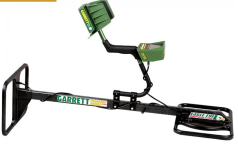Find's Treasure Forums
Welcome to Find's Treasure Forums, Guests!
You are viewing this forums as a guest which limits you to read only status.
Only registered members may post stories, questions, classifieds, reply to other posts, contact other members using built in messaging and use many other features found on these forums.
Why not register and join us today? It's free! (We don't share your email addresses with anyone.) We keep email addresses of our users to protect them and others from bad people posting things they shouldn't.
Click here to register!
Need Support Help?
Cannot log in?, click here to have new password emailed to you
Changed email? Forgot to update your account with new email address? Need assistance with something else?, click here to go to Find's Support Form and fill out the form.
You are using an out of date browser. It may not display this or other websites correctly.
You should upgrade or use an alternative browser.
You should upgrade or use an alternative browser.
Any other Garrett 24k users here using it for Gold?
- Thread starter Smigo
- Start date
Odanscoils
Well-known member
Oldkoot does.
Jim in Idaho
Well-known member
Yeah...me too. Not sure it matters who is, or isn't. I use a GM3, and TDI SL, too. And sometimes a 2 box, like the Discovery TF1200, or 900, or TM808. Lots of ways to skin the prospecting cat.
Jim
Jim
Odanscoils
Well-known member
Find anything with the two box coil ?Yeah...me too. Not sure it matters who is, or isn't. I use a GM3, and TDI SL, too. And sometimes a 2 box, like the Discovery TF1200, or 900, or TM808. Lots of ways to skin the prospecting cat.
Jim
Always wondered if you could locate a missed gold vein in the mines.
Jim in Idaho
Well-known member
Find anything with the two box coil ?
Always wondered if you could locate a missed gold vein in the mines.
Ya know, I'm just getting into the 2-box prospecting. I got a great deal on an Arc-Geo data logger, and it got me thinking about all this. I'm always trying to think outside the box. So, it made me wonder if I've been approaching the whole nugget thing from the wrong perspective. Instead of spending thousands on the latest detector, trying to find tiny gold, maybe I should switch to trying to find really big targets, like veins, or really large nuggets (rare) at depths beyond what even the best nugget detectors can reach. The input to the data logger is the headphone jack, so audio circuit. But, the logger reacts to really tiny voltage increases too small to move the diaphragm on even the best headphones. So that increases the sensitivity of the 2-boxes. The logger, with the right software, also gives you an image of the ground you've covered showing the targets it saw. The image can also be saved to study later. I just got into all this late in the summer, so got some practice, and managing the learning curve, and am now fairly adept at the concept. I'll be heading down south in January. A couple of winters back, Chris (wife of 52 years), and I found a blow hole of oxidized copper along a major quartz seam. At some point in the past, somebody had dug down in there, but at some point, quit. No evidence with BLM of a claim ever filed. Last winter I dug down about 5', and while the oxidized specimens kept coming, we never found any native copper. A friend went with us, and we both detected along the outcrop, he using a GPX 6000, and me using a GM24K. Didn't detect anything. I'm hoping the TF 1200 may do better. But, I'm also going to be doing some earth-resistivity work around the blow hole. I can reach depths of up to 100' with that, but only seeing the resistiivity of the soil. The resistivity is really boring work, but the resulting images are really interesting.
I apologize to the original poster for stepping on his thread, but I'm hoping this is relevant to what he asked.
Jim
Last edited:
Odanscoils
Well-known member
This is like my old two box detector.Ya know, I'm just getting into the 2-box prospecting. I got a great deal on an Arc-Geo data logger, and it got me thinking about all this. I'm always trying to think outside the box. So, it made me wonder if I've been approaching the whole nugget thing from the wrong perspective. Instead of spending thousands on the latest detector, trying to find tiny gold, maybe I should switch to trying to find really big targets, like veins, or really large nuggets (rare) at depths beyond what even the best nugget detectors can reach. The input to the data logger is the headphone jack, so audio circuit. But, the logger reacts to really tiny voltage increases too small to move the diaphragm on even the best headphones. So that increases the sensitivity of the 2-boxes. The logger, with the right software, also gives you an image of the ground you've covered showing the targets it saw. The image can also be saved to study later. I just got into all this late in the summer, so got some practice, and managing the learning curve, and am now fairly adept at the concept. I'll be heading down south in January. A couple of winters back, Chris (wife of 52 years), and I found a blow hole of oxidized copper along a major quartz seam. At some point in the past, somebody had dug down in there, but at some point, quit. No evidence with BLM of a claim ever filed. Last winter I dug down about 5', and while the oxidized specimens kept coming, we never found any native copper. A friend went with us, and we both detected along the outcrop, he using a GPX 6000, and me using a GM24K. Didn't detect anything. I'm hoping the TF 1200 may do better. But, I'm also going to be doing some earth-resistivity work around the blow hole. I can reach depths of up to 100' with that, but only seeing the resistiivity of the soil. The resistivity is really boring work, but the resulting images are really interesting.
I apologize to the original poster for stepping on his thread, but I'm hoping this is relevant to what he asked.
Jim
Love to see pictures and info on yours.
A lot of interesting procedures there.
Love to learn more.
Maybe start a new thread.
Attachments
Jim in Idaho
Well-known member
Smigo, do you notice any coil knock sensitivity with the Garrett version? I see that with my 10" coil in my Whites model. I don't see it with the 6" coil, or the 14".Like the title. Anyone using one for it. Hard to find people using one.
I do, 50/50 time with the 10x6 and 6" concentric. Great VLF.
Anyone?
Jim
Odanscoils
Well-known member
Nope. Too quiet.Smigo, do you notice any coil knock sensitivity with the Garrett version? I see that with my 10" coil in my Whites model. I don't see it with the 6" coil, or the 14".
Jim
Though it clearly saw the targets.
Yours sounds like a GPR.
Jim in Idaho
Well-known member
Nope...not GPR, but similar as far as results go. The 2-box is still shallow compared to the earth-resistivity setup, but a more precise result. The resistivity requires probes driven in about 10", on 1 yard increments for the best resolution. Then you have to take many, many resistance and voltage readings along the line of p;robes. First at 1 yard intervals, then 2yards, then 3 yards, etc, until you exhaust the spacings. I've got about 100 probes, so can do a 100 yardlong line. Max depth is 50 yards, but only near the center of the line.....you run out of depth because of the spacing limitations. The depth seen is equal to half the spacing of the probes you take the readings from. Then you move and set it all up and do it again, and again...you get the idea...very boring work, but does a form of prospecting nothing else can do without major disruptions of the ground, which is a BLM no-no without jumping thru a bunch of hoops. I'll be posting some images when we get back, showing what the resistivity/conductivity of that copper area looks like.Nope. Too quiet.
Though it clearly saw the targets.
Yours sounds like a GPR.
Jim
Jim in Idaho
Well-known member
Ya know, I've been casually watching for one of those, for quite awhile. Not many around. Then I stumbled on a guy (not a prospector) that haunts garage and estate sales and he had these two Discovery units. One was broken (the 900) at the stud that connected to the detector body, but the other looked complete. He was happy with $200, so I bought both. I repaired the 900, and the 1200 was great already. I like them better than my TM808 with cave mode, so going to sell it. I started out just wanting one more for backup....now have 3....go figure. The faces are identical, other than lettering, though the previous prospector owner put tape on the dials of the 900. The aluminum T-sleeve is my reapair of the broken transmit antenna on the 900.This is like my old two box detector.
Love to see pictures and info on yours.
A lot of interesting procedures there.
Love to learn more.
Maybe start a new thread.
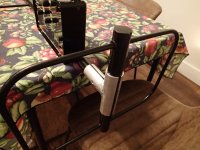
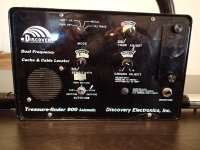
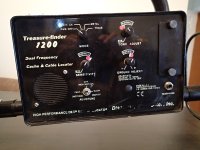
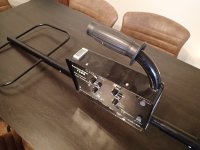
Jim in Idaho
Well-known member
These units have selectable 2-speeds of SAT, which the TM808 doesn't...its a single speed. The "trace" mode on these is the same as "Cave" mode on the TM808. on both units the Cave mode tends to eliminate ferrous targets, unless they're pretty large. My TM808 almost completely ignores my prospecting pick on the surface, when used in cave mode.
Jim
Jim
Odanscoils
Well-known member
Very interesting.Nope...not GPR, but similar as far as results go. The 2-box is still shallow compared to the earth-resistivity setup, but a more precise result. The resistivity requires probes driven in about 10", on 1 yard increments for the best resolution. Then you have to take many, many resistance and voltage readings along the line of p;robes. First at 1 yard intervals, then 2yards, then 3 yards, etc, until you exhaust the spacings. I've got about 100 probes, so can do a 100 yardlong line. Max depth is 50 yards, but only near the center of the line.....you run out of depth because of the spacing limitations. The depth seen is equal to half the spacing of the probes you take the readings from. Then you move and set it all up and do it again, and again...you get the idea...very boring work, but does a form of prospecting nothing else can do without major disruptions of the ground, which is a BLM no-no without jumping thru a bunch of hoops. I'll be posting some images when we get back, showing what the resistivity/conductivity of that copper area looks like.
Jim
Be anxiously awaiting your results.
Curious. What GPR interests you.
Do they have a resolution down to sub gram gold ?
And Telluride's ??
Odanscoils
Well-known member
That's the sad thing of mine. No much is adjustable.These units have selectable 2-speeds of SAT, which the TM808 doesn't...its a single speed. The "trace" mode on these is the same as "Cave" mode on the TM808. on both units the Cave mode tends to eliminate ferrous targets, unless they're pretty large. My TM808 almost completely ignores my prospecting pick on the surface, when used in cave mode.
Jim
GB,sens, frequencie, volume.
Jim in Idaho
Well-known member
LOL...not a chance on sub-gram gold. These are really deep detectors, but on large objects. They also react, in Cave or Trace mode, to dropping values of mineralization, excepting large targets. They are lousy for gold less than maybe 1 ounce, and that would have to be near the surface. Honestly, I have not tested them with large pieces of gold.Very interesting.
Be anxiously awaiting your results.
Curious. What GPR interests you.
Do they have a resolution down to sub gram gold ?
And Telluride's ??
Jim
oldkoot
Well-known member
Yes sir I am still using my 24K, for nugget detection, it is my favorite VLF nugget detector for sure.Oldkoot does.
oldkoot
Well-known member
My main detecting is for Nuggets and I use the 24K all the timeLike the title. Anyone using one for it. Hard to find people using one.
I do, 50/50 time with the 10x6 and 6" concentric. Great VLF.
Anyone?
Yeah there is not much out there about the 24K Whites or Garrett,other than what Steve Hershbach has posted up so its been a self taught learning experience, I sold my GM1000 to purchase the 24K and I like the 24K much better, was able to get all four coils that work on the 24K and have had no issues with any of them being knock sensitive at all, also picked up the Garrett Axiom and really liking it also, just another learning experience though, I find myself grabbing the 24K more than the Axiom just because the 24K is a fun little nugget detector to use, the nuggets I have dug have all been with the 24K.
I really need to put the 24K down leave it at home and learn the Axiom which I will at some point but as long as the 24K keeps letting me dig small bits then it is the detector I will use, everything I have dug could have been found with my Xterra 705 detector just as easily as the 24K or any other half decent VLF for that matter, so the way I look at it once I stop getting targets with the 24K then I will go back over the same areas with the Axiom and see if there might be deeper and larger nuggets there
oldkoot
Well-known member
I have not had any issues with any of the four coils I have being Knock sensitive at all Jim and I am banging in to large rocks and tree trunks all the time when I go out nugget hunting, that was one of the issues I had with my GM1000 and just one of the reasons I got rid of it, plus a few other things, I have the Garrett/Whites version of the 24KSmigo, do you notice any coil knock sensitivity with the Garrett version? I see that with my 10" coil in my Whites model. I don't see it with the 6" coil, or the 14".
Jim
Jim in Idaho
Well-known member
My 10" was replaced by Whites, just before they quit. They let me keep the bad one, but the new one, while better, still has some knock sensitivity. I know the problem spot, and need to repair it, but just haven't had the time. It's not a big deal to fix. Looks like Garrett is getting the job done. Thanks for getting back.
Jim
Jim
Smigo
Well-known member
Slow getting back sorry.Smigo, do you notice any coil knock sensitivity with the Garrett version? I see that with my 10" coil in my Whites model. I don't see it with the 6" coil, or the 14".
Jim
I get no real knock sensitivity on the 10 or the 6 inch.
Now and then a tiny bit with the 10 but its nothing annoying, no more than any coil on any other machine if I hit a rock or branch on the ground. The only time it does actually get noisy and hyper sensitive is in ground that is out of the range for the tracking, ground balance. Ground you can never get a ground balance in raising and lowering. Though it handles our highly mineralised ground really well. It cruises in ground others, vlf, struggle in. Even when its so bad I turn the gain down to 1 or 2, it still has depth and surprises me. The 6" is amazing but going forward by just a couple of inches at a time does my head in at times.
I have found a couple of negatives in regards to its construction. I had an arm rest break from just a swing coming to an abrupt end. It wasn't a big hit by any means. They are thin and flimsy really. Also my control box, head unit, can be moved side to side by just the smallest pressure on it. I taped it hard onto the shaft to stop it.
Also, the arm rest moves, just by a slight "tick" now and then during swings. I put tape under the footing of it around its edges to take up any space. It worked and stopped that tiny but annoyingly perceivable movement.
Operational wise its a brilliant vlf on gold.
Smigo
Well-known member
Hi, yeah its a pleasure to use really. My favourite vlf on gold. Still use my trusty Xterra on the relics though.My main detecting is for Nuggets and I use the 24K all the time
Yeah there is not much out there about the 24K Whites or Garrett,other than what Steve Hershbach has posted up so its been a self taught learning experience, I sold my GM1000 to purchase the 24K and I like the 24K much better, was able to get all four coils that work on the 24K and have had no issues with any of them being knock sensitive at all, also picked up the Garrett Axiom and really liking it also, just another learning experience though, I find myself grabbing the 24K more than the Axiom just because the 24K is a fun little nugget detector to use, the nuggets I have dug have all been with the 24K.
I really need to put the 24K down leave it at home and learn the Axiom which I will at some point but as long as the 24K keeps letting me dig small bits then it is the detector I will use, everything I have dug could have been found with my Xterra 705 detector just as easily as the 24K or any other half decent VLF for that matter, so the way I look at it once I stop getting targets with the 24K then I will go back over the same areas with the Axiom and see if there might be deeper and larger nuggets there



